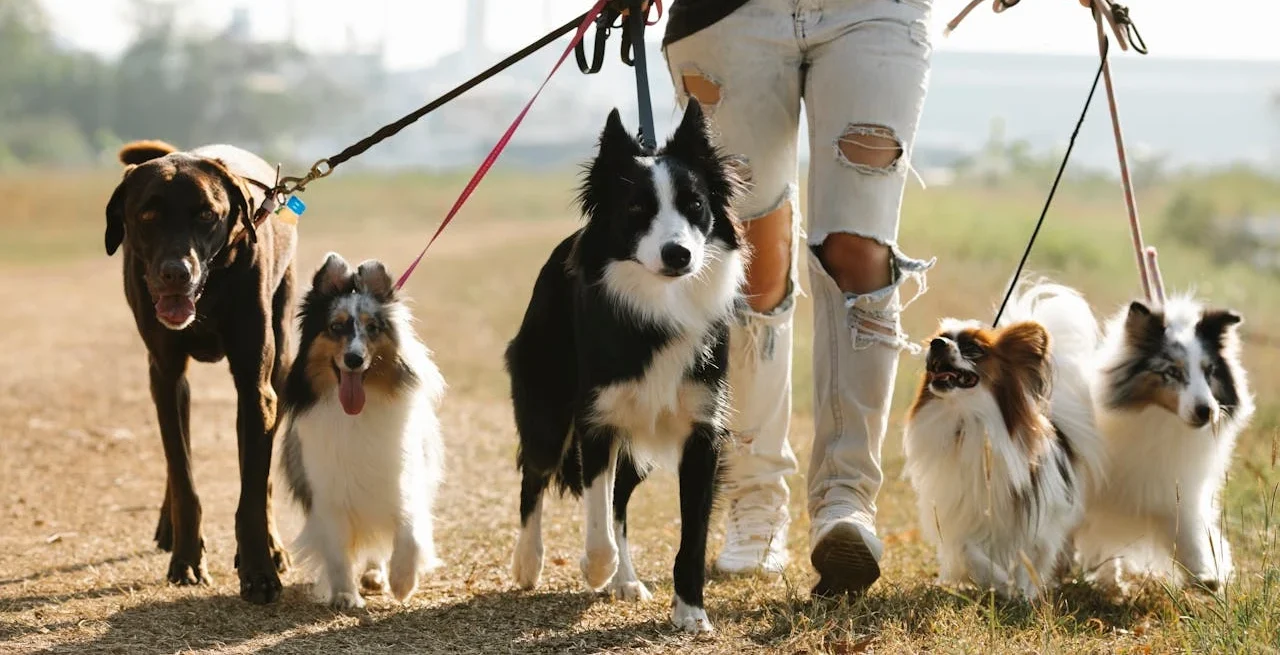Furry Therapists: How Daily Walks with Your Dog Reduce Anxiety

Table of Contents
MENTAL WEALTH PODCAST NEWSLETTER
Stay up-to-date on all blog posts and happenings. No spam, we promise!
Anxiety Causes
Anxiety is a complex emotion that can be influenced by a combination of biological, environmental, and social factors.
Here are some common causes of anxiety:
- Genetics: A family history of anxiety can make an individual more susceptible to developing anxiety disorders.
- Brain chemistry: Imbalances in neurotransmitters like serotonin, dopamine, and GABA can contribute to anxiety symptoms.
- Stressful life events: Traumatic experiences, major life changes, or prolonged exposure to stressful situations can lead to anxiety.
- Personality traits: Some personality traits, such as perfectionism, low self-esteem, or a tendency to worry, can increase the likelihood of experiencing anxiety.
- Medical conditions: Certain medical conditions, like hyperthyroidism, diabetes, or asthma, can cause anxiety-like symptoms.
- Substance use: Excessive consumption of caffeine, alcohol, or drugs can exacerbate anxiety symptoms or lead to anxiety disorders.
- Medications: Some medications, such as decongestants, bronchodilators, and steroids, can cause anxiety-like symptoms as a side effect. Withdrawal from substances like benzodiazepines or alcohol can lead to rebound anxiety.
- Personality: Traits such as perfectionism, low self-esteem, or high sensitivity to stress can increase vulnerability.
- Trauma: Past trauma, especially in childhood (e.g., abuse, neglect, or major loss), can lead to anxiety disorders later in life.
- Cognitive Patterns: Chronic negative thinking, catastrophizing, or excessive worrying can fuel anxiety.
- Stressful Life Events: Things like job loss, divorce, moving, or death of a loved one can be major triggers.
- Lifestyle: Poor sleep, lack of exercise, substance abuse (caffeine, alcohol, drugs), or poor diet can contribute.
- Social Environment: Isolation, bullying, unstable family life, or high-pressure environments can also be factors.
- Evolutionary Perspective: Anxiety is also thought to be a natural, adaptive response to danger — essentially a “fight or flight” mechanism gone overactive in modern contexts where threats are often psychological rather than physical
How you address your particular condition depends on the causes of your anxiety. So talk to a professional to understand and get the help you are looking for.
How Walking with You Dog Helps Relieve Anxiety
- Bonding with your dog: Spending quality time with your dog strengthens the bond between you, promoting feelings of love and connection. This emotional support can reduce anxiety and provide a sense of security.
- Provides Emotional Support: Dogs offer unconditional companionship and comfort, which can help reduce feelings of loneliness and anxiety. Petting your dog while walking can increase oxytocin, a hormone linked to bonding and calmness.
- Physical exercise: Walking helps release endorphins, the body’s natural “feel-good” hormones, which can reduce anxiety and improve overall mood. Exercise also reduces cortisol levels, a stress hormone that can contribute to anxiety. It also boosts endorphins, which are natural mood lifters.
- Fresh air and nature exposure: Spending time outdoors can help reduce anxiety by providing a break from the stressors of daily life. Fresh air and exposure to natural environments can also enhance mental well-being.
- Increases Exposure to Nature and Sunlight: Time outdoors, especially in green spaces, has been shown to reduce anxiety and depression. Sunlight exposure boosts vitamin D and helps regulate circadian rhythms, improving sleep quality and overall mood.
- Mindfulness and distraction: Walking your dog offers an opportunity to practice mindfulness, focusing on the present moment, and engaging your senses in the surroundings. This helps distract your mind from anxious thoughts and provides relief from anxiety. This mimics the principles of mindfulness meditation, known to reduce anxiety symptoms.
- Social interactions: Meeting other dog owners or engaging in friendly conversations with people during your walks can create positive social interactions, helping to ease loneliness and anxiety. Even a smile or nod can improve your sense of connection and wellbeing.
- Structure and routine: Dogs need regular walks, which helps you maintain a predictable daily routine—something that can ground anxious thoughts. Routines create a sense of control, which is often missing when anxiety is high.
Tips for Anxiety Management on Dog Walks
Managing anxiety during dog walks can help make the experience more enjoyable for both you and your canine companion.
Here are some tips for anxiety management on dog walks:
- Start with Deep Breathing: Before or at the start of your walk, take 3–5 deep, slow breaths (inhale for 4 seconds, hold for 4, exhale for 6). This activates your parasympathetic nervous system and helps calm anxious thoughts.
- Start small: If you’re feeling anxious about taking your dog for a walk, begin with shorter walks and gradually increase their duration as your confidence grows.
- Set a Time Goal, Not a Distance: Commit to walking for 10–20 minutes, not a specific distance. This removes pressure and lets you stop if needed without feeling like you failed.
- Choose less crowded areas: Opt for quieter routes, parks, or trails to minimize exposure to potential triggers, such as large groups of people or heavy traffic.
- Practice relaxation techniques: Engage in deep breathing exercises or other relaxation techniques before and during your walk to help ease anxiety symptoms.
- Choose Natural Environments: Walks in green spaces, parks, or quiet wooded areas are especially calming. Nature exposure reduces cortisol and improves mood—often more than urban settings.
- Plan your route: Familiarize yourself with your planned route to reduce anxiety related to the unknown. Having a clear idea of your walking path can provide a sense of security and control.
- Walk with a friend or family member: Inviting a supportive friend or family member on your dog walks can provide comfort, reassurance, and positive social interaction.
- Let Your Dog Lead Sometimes: Let your dog sniff and explore—this relaxes them and gives you time to slow down. The slower pace can help your nervous system relax too.
- Practice Mindful Observation: Focus on your dog’s enjoyment – shifting your attention to your dog’s happiness during walks can help distract you from anxious thoughts. Take joy in observing your dog’s excitement as they explore and engage with their environment. Tune into small details: birds, leaves, clouds, scents. This pulls your focus out of anxious mental loops and into the present moment.
- Talk to Your Dog: Speaking to your dog in a calm, reassuring voice can soothe both of you. It also helps shift your attention from internal thoughts to external connection.
- Create a consistent routine: Establishing a regular walking schedule can help reduce anxiety by providing structure and predictability. Stick to a consistent time, route, or duration to promote a sense of familiarity.
- Reflect Afterwards: After the walk, write down how you felt before and after. This helps you see progress over time and can reinforce the positive effects.
- Make it Routine: Anxiety thrives on unpredictability. A regular walking schedule adds structure and predictability to your day, which lowers baseline anxiety.
- Seek professional guidance: If your anxiety persists or becomes overwhelming, consider seeking guidance from a mental health professional. They can provide personalized strategies to help manage your anxiety during dog walks.
By implementing these tips, you can make dog walks more manageable, helping you enjoy the numerous benefits of exercise and companionship with your furry friend. If anxiety still feels overwhelming, you might also benefit from combining walks with professional tools—like therapy, journaling, or guided meditation apps.
When to Speak with Your Doctor about Anxiety Symptoms
- Symptoms Last More Than a Few Weeks (Chronic Anxiety): Occasional anxiety is normal—but if symptoms last more than 2–4 weeks, or keep coming back, it’s time to talk to a doctor.
- Intense symptoms: Experiencing severe anxiety symptoms, such as panic attacks, racing heart, shortness of breath, or feelings of losing control, should prompt a conversation with your doctor. Symptoms such as chest tightness or palpitations, digestive issues (nausea, diarrhea), insomnia or disrupted sleep, or fatigue or restlessness need to be taken seriously and seek professional help.
- Impaired daily functioning: If your anxiety interferes with your ability to carry out daily activities, such as work, school, or social interactions such as withdrawing socially or struggling to complete routine tasks., seek your doctor’s advice.
- Physical symptoms: Anxiety can cause various physical symptoms, including headaches, digestive issues, or chronic pain. Discuss these symptoms with your doctor to determine if they may be related to anxiety.
- Changes in mood or behavior: If you notice significant changes in your mood or behavior, such as increased irritability, restlessness, or social withdrawal, speak with your doctor about potential anxiety-related causes.
- Constantly Worrying: Your thoughts feel out of control, racing, or overwhelming. You can’t “turn off” worry, even when there’s no clear cause. Small problems feel like huge threats.
- Co-occurring mental health conditions: Anxiety often coexists with other mental health conditions, like depression or substance abuse. Discuss your mental health concerns with your doctor to develop a comprehensive treatment plan.
- Ineffective self-help strategies: If you’ve tried various self-help techniques, such as relaxation exercises, mindfulness, or lifestyle changes, without significant relief, it’s time to consult your doctor for additional guidance.
- Unhealthy Coping Mechanisms: Relying on alcohol, caffeine, or drugs to calm down or fall asleep. Avoiding important responsibilities or relationships to escape anxious feelings.
- History of Mental Health Issues: If anxiety runs in your family or you’ve experienced depression or trauma before, early treatment can prevent it from worsening.
- Thoughts of Self-Harm or Hopelessness: If you feel like you can’t go on, or you’re thinking about hurting yourself, seek help immediately—from a doctor, therapist, or crisis line.
A Walk a Day Helps Keep the Anxiety at Bay
To your stronger mental health!
MENTAL WEALTH PODCAST NEWSLETTER
Stay up-to-date on all blog posts and happenings. No spam, we promise!
